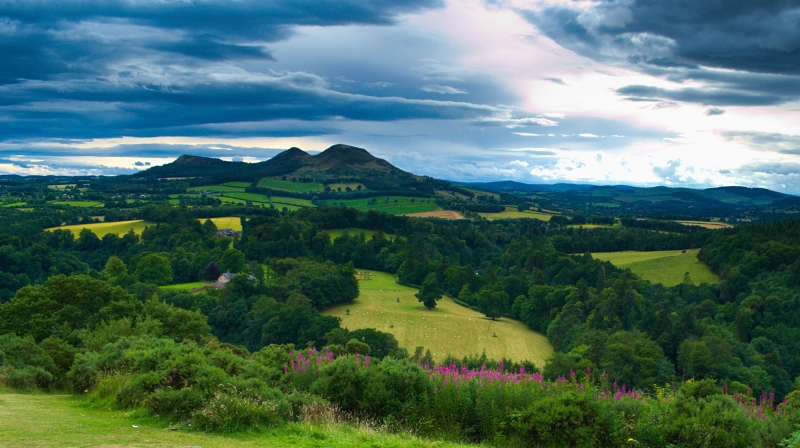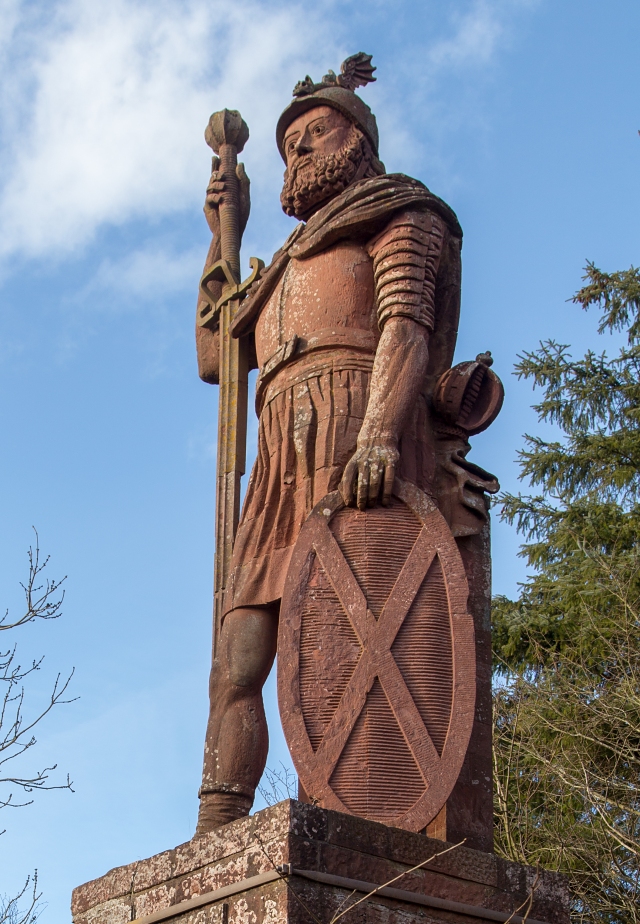
Near the entrance to Bemersyde we are pleased to find a sign marking the pathway to the statue. We pull into a small graveled area that serves as a car park and immediately enter a wooded area.
This trail seems to go on forever. The path is narrow and heads first uphill, then downhill through the trees. A thicket of brambles laden with thousands of unripe berries borders the path for much of the way. At one point the trees give way, affording a view of rolling hills and pastures. I'm beginning to feel a bit like Gretel, wondering where the bread crumbs have gone.
We walk and walk, and walk some more over the uneven ground and then – the path ends abruptly. The ground drops away to a steep declivity. Looking out across the valley the River Tweed is visible, snaking through green and yellow fields and copses of dark green trees, disappearing and reappearing at the foot of rolling hills. Bordering this idyllic panorama to the west, are the peaks of the Eildon Hills.
Turning my head to the right, and looking up I feel my mouth drop open in awe at the enormity of the statue. Standing sentry over the valley is the guardian of Scotland. William Wallace, portrayed in red sandstone, and looking a bit like a Roman soldier, rises up into the sky like an angel.
"Great Patriot Hero. Ill-Requited Chief," the engraving reads. Wow. Commissioned in 1814 by the Earl of Buchan, whose love of this country is evident in his preservation of the ruins at Dryburgh, the statue stands about thirty feet tall in these secluded woodlands of beech and Scots pine. Robin finds a little tin box atop a pole, which contains a guest book. I sign my name, adding "Pro Libertate" – the Clan Wallace motto – "For liberty".
The walk back to the car seems shorter, and soon we are on our way to Scott's View. The view from this hill, overlooking the Eildon Hills and Trimontium, site of a Roman fort, is breathtaking. Local tradition states that when Sir Walter Scott died, his horses, which were pulling his casket, stopped here on their way to Dryburgh Abbey. They were so accustomed to pausing here for Scott to gaze out over his beloved Borders that they stopped by themselves.
Robin gets adventurous and disappears down the hill while Dana and I stand by the car smoking (cough). The road is deserted, and I turn around full circle taking in the gorgeous view from all perspectives. I'm struck by the sheep-covered hill behind us, and the cloud that hangs over it. The contours of the hill and cloud are mirrored and I can't help but take a picture.
Heading back to the yellow road in order to connect with the red road that will take us back to Melrose, Dana spies a standing stone in the middle of a field. We pull over and take shots of this too. It reminds me of the Devil's Arrows back in Yorkshire; it's just there – where it has been for who know how long – with no explanation.

The William Wallace Statue in the grounds of the Bemersyde estate, near Melrose in the Scottish Borders, was commissioned by David Steuart Erskine, 11th Earl of Buchan.
The statue was made of red sandstone by John Smith of Darnick and was erected in 1814. It stands 31 feet high and depicts Wallace looking over the River Tweed.
Read more about the William Wallace Statue at Wikipedia.